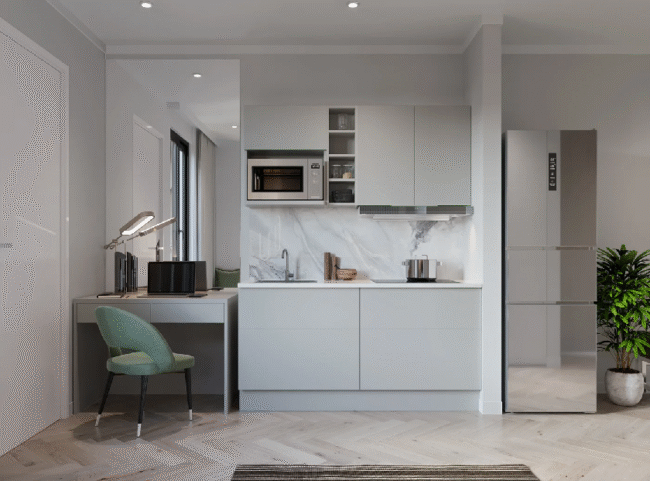
The urban lifestyle comes with its unique set of challenges, particularly when it comes to making the most of limited square footage. Small apartment living demands creative solutions that maximize functionality without sacrificing style or comfort. The art of space optimization through furniture selection has evolved dramatically in recent years, with designers increasingly focused on creating pieces that serve multiple purposes while maintaining aesthetic appeal.
The Renaissance of Multifunctional Design
Space-saving furniture represents more than just practical solutions—it embodies a philosophy of intentional living. Each piece must earn its place within a compact environment by offering versatility beyond its primary function. This approach transforms limitations into opportunities for innovative design.
Murphy beds, those ingenious fold-away sleeping solutions popularized in the early 20th century, have made a remarkable comeback in contemporary small apartment design. According to House Beautiful’s 2025 small space design guide, “These Renowned Experts Say Murphy Beds Are BACK,” highlighting their renewed popularity among space-conscious homeowners and designers alike. The modern iterations bear little resemblance to their clunky predecessors, now featuring smooth mechanisms, integrated storage, and seamless integration with surrounding décor.
Have you considered how much usable space is lost to single-function furniture pieces? The average bed occupies approximately 30 square feet of floor space that remains largely unused during waking hours. This reality has driven the development of bed systems that convert to desks, sofas, or storage units when not needed for sleeping.
Living Room Solutions: Flexibility Redefined
The living room presents particular challenges in small apartments, needing to function as entertainment space, work area, and sometimes even guest accommodation. Modular seating has emerged as a primary solution, allowing configurations to change based on immediate needs.
In my experience consulting with apartment dwellers, the most successful living room arrangements incorporate nesting tables that can be expanded when entertaining or tucked away when not in use. These simple yet effective pieces provide surface area on demand without permanently claiming precious floor space.
The concept of “casual comfort” has gained significant traction in recent furniture design. As Decorilla’s 2025 interior design trends report notes, “2025 interior design trends embrace casually comfortable furniture, focusing on creating relaxed spaces without compromising on style. It’s all about furniture that is as practical and cozy as it is aesthetically pleasing.” This approach acknowledges that small space living shouldn’t require sacrificing comfort for functionality.
Storage ottomans exemplify this dual-purpose philosophy, serving as seating, surface area, and hidden storage simultaneously. When selecting these pieces, consider materials and construction that can withstand daily use in multiple capacities—durability becomes even more critical when furniture must perform several functions.
Dining Areas: From Feast to Compact
Traditional dining tables consume substantial space even when not in use for meals. Drop-leaf and extendable tables provide the perfect solution, offering minimal footprints during regular days while expanding to accommodate guests when entertaining.
Case studies show that apartments utilizing wall-mounted drop-down tables recover approximately 15 square feet of usable floor space compared to those with traditional dining tables. This reclaimed area creates meaningful improvements in movement and perceived spaciousness.
Wall-mounted dining solutions have advanced considerably beyond basic folding tables. Current designs feature elegant brackets, integrated storage for dining items, and surfaces that double as artwork or mirrors when folded up. The transformation from practical dining space to decorative wall element represents the ideal melding of function and aesthetics.
Kitchen Innovations: Maximum Utility in Minimal Space
Kitchen areas in small apartments often suffer from limited counter and storage space. Pull-out cutting boards, nesting cookware, and collapsible kitchen tools address these limitations without requiring structural renovations.
Islands on wheels provide adaptable work surfaces that can be positioned as needed and tucked away when not in use. Many feature integrated storage, additional seating options, or specialized functions like built-in composting systems.
Would your cooking habits change if your kitchen could expand and contract based on your immediate needs? The psychological impact of adaptable spaces extends beyond simple convenience to fundamentally alter how we interact with our environments.
Bedroom Solutions: Beyond the Murphy Bed
While Murphy beds have experienced a renaissance, they represent just one approach to maximizing bedroom space. Platform beds with integrated drawers eliminate the need for separate dressers, while loft beds create usable areas underneath for desks, seating, or storage.
Wardrobes with sliding doors require less clearance than traditional hinged versions, making them ideal for tight spaces. Modern designs incorporate interior organizers that maximize capacity while maintaining accessibility—a crucial consideration when storage options are limited. You can find wardrobe design inspiration from OPPEIN.
In my experience designing for micro-apartments, the most successful bedroom furniture incorporates lighting elements, eliminating the need for separate lamps and the surfaces they would occupy. Headboards with integrated shelving and lighting create vertical storage while maintaining a cohesive design aesthetic.
Office Spaces: The Home Workplace Revolution
The rise of remote work has intensified the need for dedicated home office spaces, even in the smallest apartments. Fold-down desks mounted to walls provide work surfaces that disappear when not needed, while secretary desks offer elegant solutions that close up to conceal work materials.
The psychological advantage of being able to “close the office” at the end of the workday shouldn’t be underestimated, particularly when living and working in the same compact environment. Physical boundaries help maintain mental separation between professional and personal life.
The Vertical Dimension: Often Overlooked
Small apartment dwellers frequently fail to fully utilize vertical space. Floor-to-ceiling bookcases, hanging storage systems, and wall-mounted organizers expand capacity without consuming floor area.
The adaptive reuse trend highlighted in Decorilla’s 2025 design forecast emphasizes that “reclaimed materials” can breathe new life into spaces while reducing environmental impact. Wall-mounted systems crafted from repurposed materials create distinctive storage solutions while contributing to sustainability goals.
Have you considered the aesthetic impact of wall-mounted storage? Beyond their practical benefits, these systems draw the eye upward, creating an illusion of greater height and spaciousness that expands perceived dimensions.
Bathroom Efficiency: Small Changes, Big Impact
Bathroom spaces present unique challenges in small apartments, with limited floor space and competing functional needs. Vanities with built-in storage eliminate the need for separate cabinets, while wall-mounted fixtures maximize floor clearance.
Over-toilet storage units and shower caddies utilize otherwise wasted space, while medicine cabinets with integrated lighting reduce the need for separate fixtures. These small interventions accumulate to create significantly more functional bathrooms without structural modifications. You can look for one professional cabinet brand for the customization service.
Smart Furniture: Technology Meets Space Saving
The integration of technology into furniture design has created new possibilities for space optimization. Beds that raise to the ceiling via automated systems, tables that adjust height and size through app controls, and modular pieces that transform through mechanical innovation represent the cutting edge of space-saving design.
The psychological benefit of furniture that adapts to changing needs extends beyond simple convenience to create environments that respond to their occupants. This interactive quality transforms small spaces from constraining to empowering.
The Psychology of Space-Saving Design
The impact of well-designed space-saving furniture transcends mere practical benefits. Living with pieces that cleverly adapt to changing needs creates a sense of control even within limited square footage. This psychological advantage may explain why multifunctional furniture remains popular even when larger spaces become available.
Case studies of individuals who’ve transitioned from small apartments to larger homes often reveal that they maintain their preference for adaptable furniture. The experience of thoughtful space utilization creates lasting appreciation for design efficiency regardless of spatial constraints.
Sustainability and Space Saving: Natural Partners
The philosophy behind space-saving design aligns naturally with sustainability principles. Furniture that serves multiple functions reduces overall consumption, while quality construction ensures longevity that minimizes waste.
In my experience, clients who initially pursue space-saving solutions for practical reasons often develop deeper appreciation for sustainability aspects. The mindfulness required for successful small-space living frequently extends to broader environmental awareness.
The relationship between space efficiency and environmental responsibility continues to strengthen, with manufacturers increasingly emphasizing sustainable materials and construction methods in space-saving lines. This convergence represents a promising direction for future furniture design.
When considering space-saving furniture for your small apartment, remember that each piece should serve multiple functions while reflecting your personal aesthetic. The best solutions enhance both functionality and beauty, transforming spatial limitations into opportunities for creative expression. Have you discovered that your favorite piece of furniture is actually one that saves space?
